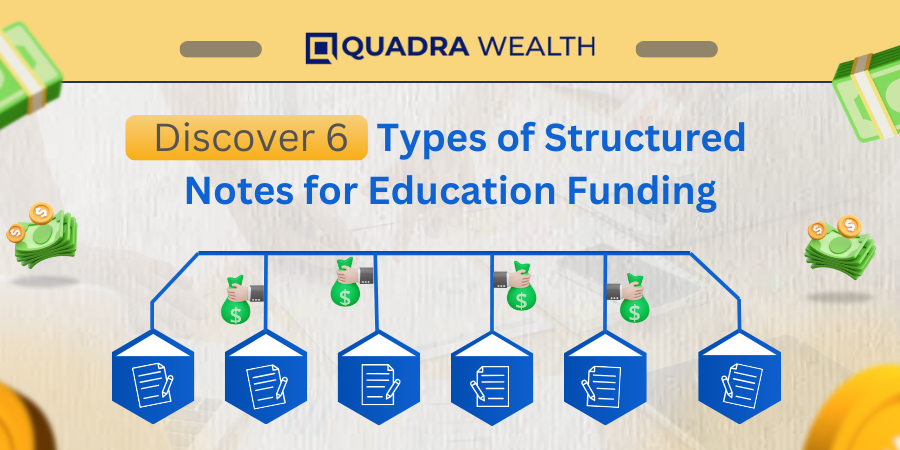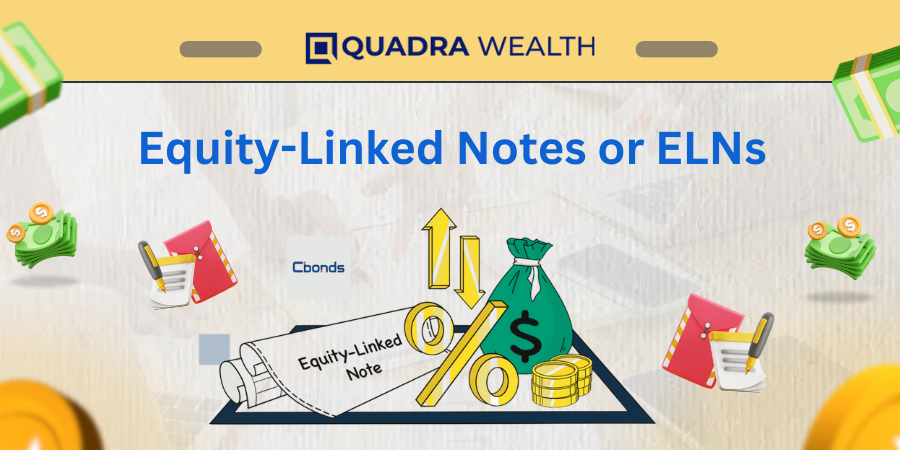Introduction
When you plan to invest in a portfolio, you must introspect into two different things:
- Does the investment plan help you fulfill your immediate financial needs?
- Are there specific investment plans in the market to cater to your short-term or medium-term financial objectives?
You must answer these two primary questions to get better ideas about what you are looking for.
When it comes to education funding, you typically look for short-term to medium-term investment plans. You may have to tender tuition fees once a year, once every 6 months, or post the end of each semester.
Therefore, choosing short-term or medium-term investment plans is going to solve your overall purpose here.
Let us deep dive into 6 specific types of structured notes for education funding purposes alone. Helping you get started with the same:
1. Principal-Protected Notes or PPNs
These are structured notes that are primarily designed to protect an investor’s principal amount or capital investment. The note has its bond component invested via fixed-income annuities or coupon bonds so that the investor’s capital amount is preserved at any cost.
The investor can also link underlying equity assets like stocks, securities, or currencies to improve the upscale potential to earn better returns via the performance of underlying assets in the market.
However, the returns the notes earn are subject to how the assets/ derivative components perform in volatile market conditions and the payouts or return on investment with notes can be variable or dynamic.
In a crux, principal-protected notes or PPNs preserve your principal amount and therefore this is the right type of investment option that you must choose to fund education fees for your sons or daughters out there.
2. Gold-Linked Notes or GLNs
Gold-linked notes or GLNs are short-term investment plans that can take care of your immediate financial objectives in a succinct manner indeed. The investors buy ounces of gold at discounted purchase values and can redeem the gold at prevailing market prices.
When the price of gold goes above strike rates, then they get a cash settlement in lieu of the market price of gold.
Otherwise, the investment gets converted into gold bars or coins that get credited into the GLN investor’s gold account. This is in case the gold values do not touch strike rates or initially designed purchase points as such. Here, the investor can wait for the gold prices to rise so that they can get their redemption via cash or bank settlement. The liquidity for gold is also quite good and the investors can sell the accrued gold via secondary marketplaces too.
GLNs therefore serve the short-term or medium-term expenses like education funding in a hassle-free manner.
3. Reverse Convertible Notes or RCNs
Reverse convertible notes or RCNs are good investment options that can take care of your short-term or medium-term financial objectives in a comfortable manner. And education funding is surely one of them!
The investor purchases RCNs and these are notes that are linked to equity-based derivatives like shares, basket of stocks, and currencies, to name a few.
The initial points or strike values must be achieved concerning underlying assets the RCNs are linked to. This is the primary consideration for investors to get their principal and returns on investment as a cash or wireless settlement during the time of maturity of the investment portfolio.
If the final sale points of underlying assets do not meet the pre-designed criteria, then investors can have their principal investment converted into shares of the underlying firms. This can later be sold in the secondary market or you can allow the assets to reach their desirable sale points.
And, RCNs are short to medium-term investment plans that help investors fulfill their financial objectives in this timeline.
4. Equity-Linked Notes or ELNs
Equity-linked notes or ELNs are short to medium-term notes wherein you have the fixed portion of the notes that get linked to underlying equity-based assets. Investors usually choose high-paying stocks, a basket of shares, or currencies to name a few.
These notes provide downside protection to the capital investment. However, the performance of underlying assets primarily determines whether investors receive their principal money along with returns on the investment at the time of redemption.
ELNs are meant for those investors who have reasonable risk tolerance for equity exposure as the assets can rise or plummet on account of volatile market conditions. Therefore, the returns on a structured note of this kind are highly variable This investment option therefore is not meant for those investors who cannot take market risks connected with equity exposure.
5. Autocallable Notes
Autocallable notes are financial products that have an in-built auto-calling facility that product issuers embed into these notes. The notes are linked to underlying assets like equity shares, stocks, and currencies. The performance of underlying assets gets monitored during said observation periods also known as observation dates.
When the price of assets reaches their initial par strike values or goes above the preset points the notes get autocalled or redeemed. The product issuers do not wait until the maturity term of the asset to auto-call notes as they are done every quarter or half-yearly period too.
Once the notes get auto-called investors receive their principal money and coupon payments from the asset too. This can be a short to medium-term asset component as the notes get auto-called from time to time. You can also re-invest into similar notes with better interest rates to keep getting regular income sources in the form of coupon payouts.
Therefore, investing in autocallable notes is a good way to fund the education of your sons/ daughters.
6. Hybrid Products
You can choose two or two types of structured products to diversify your investment portfolio. While you do so, you can look for complex business elements like risk management or profiling taken care of.
At the same time, investors get better opportunities for increasing their secondary income sources as they can be eligible for coupon payouts, interest earnings, or dividend disbursements if your customized set of products facilitates income or growth notes into the portfolios.
By customizing two or more varieties of structured notes into your investment portfolio, you can get a tailor-made solution that takes care of principal protection, income generation, and market exposure all at one go.
You can approach a financial advisor who is well-experienced so that he can help you choose notes issued by financial institutions of higher repute.
Who Issues Structured Notes?
Notes are usually issued by investment banks or financial conglomerates to sophisticated investors or individual investors of high net worth. These notes provide exposure to the bond portion as well as a derivative portion rate-linked to the performance of underlying assets.
With respect to structured products, the structured notes may comprise commodities, referenced assets covering one part of the investment, and fixed income proponents covering the rest of the investment.
Therefore, this is an investment decision you probe into before foraying.
What are the Primary Prerequisites for Choosing a Good Investment Plan?
These are the primary prerequisites for choosing a good investment plan. Helping you through with a run-down into the same:
1. Transparency
The investment plan must be transparent and not have hidden elements for the investor and the product issuing firm. What is the nature of the investment plan? What features does the plan carry within its whim? What type of returns can the investor expect from the investment plan? Are the rate of returns fixed payments or floaters?
These are a few questions an investor must pose to the banker or financial organization with whom he is signing up.
There must be a certain level of transparency between the investment holder and the product issuer to make sure that the investment plan is a green-flagged one.
2. Credibility of the Product Issuing Firm
More often than not, investors fail to check this one out. In your overall eagerness to sign up with an investment plan that can take care of your immediate or long-term financial needs, you might fail to look beneath the waters.
The investor must gauge the credibility of the investment firm, wealth management console, or bank you are signing up for a plan. The credibility of the product issuing firm can have a direct impact on whether you get a principal return plus payouts at the time of redemption.
If you sign up without going deeper into looking at the credibility of the product issuer and the issuing firm signs up for bankruptcy or insolvency, you may end up losing the entire portion of your capital or principal investment amount.
3. Understanding the Overall Risk Factors of Investment Plans
Learning or understanding the overall risk factors of investment plans is like test-driving a car before planning its purchase. As an investor, you must understand the overall risk factors of an investment plan that stands chosen.
This can be done by reading the foreclosure or initial screening investment documents from start to finish. You can check for terms and conditions that are displayed via the online website of the said investment house.
When you do this, you have a clearer picture of whether the investment plan is a risky one or a safer one for you to foray into. Not doing so is at the risk of losing your hard-earned money which is something you are not looking at.
4. Knowing How Fee Structures Work
You must have a tete-a-tete conversation with a wealth manager or an independent financial analyst who designs an investment plan for you as such. You can discuss how fee structures work. This way, you can calculate how much returns you get from the investment plan you aim to choose less fees paid out.
Some of the investment plans have complex fee structures and these are levied in the name of transacting fees, brokerage commissions, early redemption fees, administrative fees, and so on and so forth.
When you know about how fee structures work and the plan does not leave you with ample returns and return of capital at the end of redemption, then this is not the plan you are going to have green-flagged on your checklist.
The Bottom Line
Structured notes comprise debt and equity and the notes are traded as hybrid products. Therefore, you have a fleet of risk factors like credit risks, liquidity risks, and market risks to name a few.
Investors must read through the offer documents to know what they are signing up for. To make a prudent decision on investing, some bit of homework from your end is also essential.










